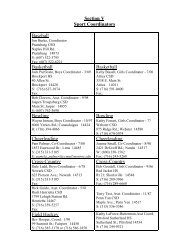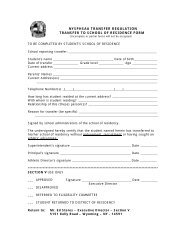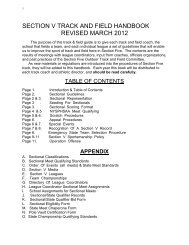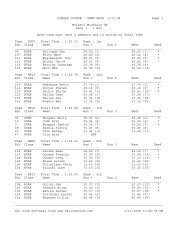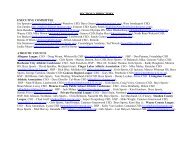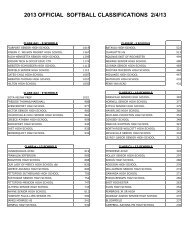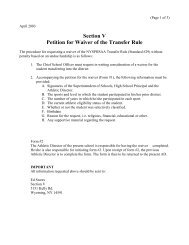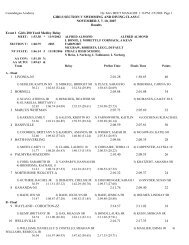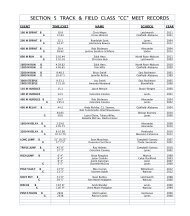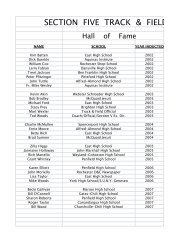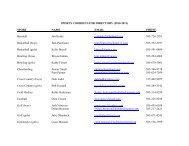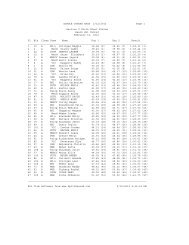CONCUSSION MANAGEMENT PROTOCOLS - Section V Athletics
CONCUSSION MANAGEMENT PROTOCOLS - Section V Athletics
CONCUSSION MANAGEMENT PROTOCOLS - Section V Athletics
You also want an ePaper? Increase the reach of your titles
YUMPU automatically turns print PDFs into web optimized ePapers that Google loves.
<strong>CONCUSSION</strong> <strong>MANAGEMENT</strong> <strong>PROTOCOLS</strong><br />
Cynthia DiLaura Devore, M.D., M.A., M.S., F.A.A.P.<br />
1
TABLE OF CONTENTS:<br />
Introduction<br />
Prague Guidelines<br />
Sample: Emergency protocols for coaches and athletic trainers for managing serious injuries<br />
or conditions on the field<br />
Sample: Parent instructions after head/face/neck/spine injury<br />
Sample: Physician Evaluation of Student Athlete Following Head Injury<br />
Sample: Accident/incident parent notification form<br />
2
INTRODUCTION:<br />
Mild traumatic brain injury (MTBI), commonly known as concussion, is one of<br />
the most common neurologic disorders. Schools can improve patient<br />
outcomes when MTBI is suspected or diagnosed by encouraging early<br />
treatment and appropriate referral and limiting cognitive demands on a newly<br />
injured child until they have been symptom free for at least 24 hours. Once<br />
symptom free, they may need a gradual re-entry to academic demands.<br />
Early MTBI symptoms may appear mild, but they can lead to significant, lifelong<br />
impairment in an individual’s ability to function physically, cognitively,<br />
and psychologically. Although currently there are no standards for treatment<br />
and management of MTBI, appropriate diagnosis by a physician, referral to a<br />
specialist for serious injury, and patient and family education to avoid further<br />
damage with re-injury are critical for helping MTBI patients achieve optimal<br />
recovery and to reduce or avoid significant sequelae.<br />
Each year in the United States approximately 1.5 million Americans sustain<br />
traumatic brain injuries, ranging from mild to severe, and, of those, 50,000<br />
people die from TBIs.<br />
Because MTBI symptoms may evolve over days, it is important that<br />
educational teams are aware of the impact head injury has on a student.<br />
Cognitive symptoms may include: difficulty focusing, problems attending,<br />
diminished concentrating, memory deficits, especially short and medium term<br />
memory problems, slow response time, or word retrieval issues.<br />
The student may experience physical and behavioral symptoms while in<br />
school, such as emotional lability, irritability, mood swings, depression, or<br />
anxiety. The student may be sleepy if he/she is having sleep disturbances at<br />
home. They may not remember things they already learned and may<br />
demonstrate a loss of initiative or motivation. They may complain of<br />
headaches, dizziness, fatigue, nausea, or blurred vision.<br />
Concussion in sports is a term that seems less significant than what actually<br />
happens in an head injury: traumatic brain injury. The severity of the trauma<br />
depends on the degree of injury, and happily, most sport related concussions<br />
result in mild traumatic brain injury. However, mild traumatic brain injury in<br />
sport is a significant condition that affects 1.6 to 3.8 million student athletes.<br />
Symptoms may last from several minutes or hours to days, weeks, or months.<br />
Severe injury can result in permanent disability and even death. Yet, with<br />
most sport related head injury, proper diagnosis and management can see<br />
full recovery in most patients.<br />
In 2004, the Prague International Conference on Concussion reviewed<br />
concussion and established new guidelines for proper diagnosis and<br />
treatment. This current document is based on the Prague guidelines and is<br />
designed for schools to use to implement the best practices currently<br />
3
available in the proper recognition, management, and return to play following<br />
concussion.<br />
Sample forms and letters are available at the end. As this is a relatively new<br />
approach to mild traumatic brain injury, the expectation is that each district<br />
should attempt to work toward educating parents, coaches, students, athletic<br />
trainers, and even community physicians and in implementing basic common<br />
sense approaches to decrease the risk of further injury to student athletes<br />
and to have the best possible outcomes following injury. If costs will not<br />
allow full implementation of the protocols, efforts should be made to develop<br />
a three to five year plan to ensure there is a positive trajectory established in<br />
the proper management of mild traumatic brain injury associated with sports.<br />
Each district is encouraged to involve and work closely with the school<br />
physician and school nurse who can alleviate the burdens of responsibilities<br />
that coaches often feel when they are left alone to make what amount to<br />
medical decisions. Until there is widespread education of the community<br />
physicians, there may be times when what the private physician recommends<br />
may differ from current practice suggestions, because old standards of care<br />
may still be in use. However, a team approach can go a long way in assuring<br />
that all children across NYS receive the best possible care that is available to<br />
them following head injury.<br />
PRAGUE <strong>CONCUSSION</strong> GRADING DEFINITIONS<br />
Simple:<br />
An athlete suffers an injury that progressively resolves without complication over 7 to 10<br />
days. In such cases, the athlete must restrict cognitive and physical activity while<br />
symptomatic in any way, and in general no further intervention is required during<br />
recovery. After rest until all symptoms resolve and IMPACT testing is back to baseline<br />
can be followed by a graded program of exertion outlined below. All concussions must<br />
be managed by a medical doctor.<br />
Complex:<br />
An athlete suffers persistent symptoms, including persistent symptoms on exertion, has<br />
specific neurological symptoms in the actual injury (such as loss of consciousness for ><br />
1 min; amnesia, seizure), or has prolonged cognitive impairment or post concussive<br />
symptoms. This group also includes athletes who suffer multiple concussions over time.<br />
These athletes must be followed by medical specialists in concussion management and<br />
cleared by them as symptom free; must return to baseline in the IMPACT testing; and<br />
must be completely symptom free on exertion for a minimum of one week and as much<br />
as three months or more for significant injury, brain surgery, post-concussive syndrome.<br />
Graduated Return to Physical Exertion and Activity:<br />
There is a six phase or step gradual return to activity. The return to play (RTP) protocol<br />
may not start until an athlete is completely symptom-free for a full 24 hours, and must<br />
remain symptom-free following each stage before progressing further. At any time<br />
symptoms return after a stage completion, the athlete must rest again until a full 24<br />
4
hours symptom-free has elapsed, at which time the progression can restart at stage 1.<br />
No steps may be skipped or combined to speed up the process. The steps are:<br />
1. The graduated re-conditioning program is as follows:<br />
STEP 1 low impact non-strenuous light aerobic activity for short intervals, such<br />
as easy walking, biking, swimming in three ten minute intervals; no resistance<br />
training<br />
STEP 2 higher impact, higher exertion activity in two 15 minute intervals, such<br />
as running/jumping rope, skating, or other cardio exercise; may be sports specific<br />
if available (e.g. skating without collision meaning suited up, but skating when the<br />
team is not doing drills; running without impact in soccer or football, suited up),<br />
no resistance training<br />
STEP 3 repeat day Day 2 progressing with shorter breaks, and add 10 to 15<br />
min. stationary skill work, such as dribbling, serving, tossing a ball (balls should<br />
not be thrown or kicked in the direction of the student); low resistance training if<br />
available with spotting<br />
STEP 4. repeat Day 3 without breaks in cardio, but add skill work with movement<br />
(allowing balls to be thrown/kicked in the direction of student); non-contact<br />
training drills<br />
STEP 5. repeat Day 4 as a warm up; weight lifting with spotting; full contact<br />
training drills<br />
STEP 6 warm up followed by full participation in game play as tolerated<br />
SAMPLE BOARD OF EDUCATION POLICY<br />
<strong>CONCUSSION</strong><br />
The Board of Education recognizes the seriousness of head trauma of any<br />
sort, in and out of school, and the potentially progressive nature of an impact to<br />
the head especially during the first week following injury where re-injury can<br />
result in second impact syndrome, more severe injury, and long term disability<br />
and even death to the student.<br />
The Board further recognizes the evolving research that has demonstrated<br />
the importance to provide all students with any degree of concussion appropriate<br />
safeguards and educational accommodations during the healing phase of their<br />
recovery. Because of the short-term nature of concussion, a student may require<br />
significant short-term program modifications without the benefit of an IEP or 504<br />
Plan already in place.<br />
The Board finally recognizes that well-informed parents, athletes, and<br />
5
staff are the greatest prevention measures to avoid those instances of<br />
preventable head injury and to minimize risks with unavoidable injury through<br />
early recognition and management.<br />
Accordingly, the____________ School District will adhere to all state and<br />
federal laws governing the rights of students with special medical needs and will<br />
take reasonable measures to work with both the health care provider and the<br />
family to ensure the health and safety of all students including children with<br />
concussion. This policy encompasses any physician documented traumatic brain<br />
injury. Reasonable measures may include, but are not limited to:<br />
• providing training for educational teams, athletic staff, parents, and<br />
students about prevention strategies, the risks of head injury associated<br />
with sports, proper use of personal protective equipment and devices, and<br />
importance of reporting injuries promptly to an adult who can help them.<br />
Education will also address the aftermath of any injury to the head, inside<br />
or outside of school, and the importance of cognitive and physical rest<br />
during healing.<br />
• having standing emergency medical protocols for athletic staff and club<br />
supervisors created by the district physician;<br />
• maintaining a concussion management team in the district as selected by<br />
the superintendent (or designate) to include key personnel in academics,<br />
physical education, athletics, and health services to oversee and<br />
implement concussion management protocols at each building level.<br />
• assuring appropriate and reasonable building accommodations are in<br />
place within a reasonable degree of medical certainty as a student is<br />
healing which may include testing accommodations not previously<br />
specified, homework and project extensions, incompletes without typical<br />
penalties, and other short term academic accommodations that will not<br />
last long enough to warrant an IEP or 504 Plan.<br />
Furthermore, the district will implement in its concussion management<br />
protocol standardized measures of assessment of injured students and<br />
adherence to a return to mental and physical exertion on a progressive program<br />
consistent with guidelines from the New York State Public High School Athletic<br />
Association and in accordance with any laws governing the State of New York.<br />
6
<strong>CONCUSSION</strong> <strong>MANAGEMENT</strong> PLAN<br />
ACADEMIC RE-ENTRY<br />
ACADEMIC RE-ENTRY PLAN<br />
Once a student has been diagnosed with concussion by a health care provider, the<br />
student should remain at home until he/she has been cleared to return to school. While<br />
tutoring may be provided with medical justification, it should only be done based on a<br />
student’s ability to participate safely and without symptoms.<br />
Once the student returns to school, the school nurse and/or AT will do the same daily<br />
monitoring of the student that is done for re-entry to physical activity including physical<br />
education and interscholastic sports, using a standardized assessment tool, like ACE or<br />
SCAT among others. The nurse and/or AT will share his information with the counseling<br />
office. The school nurse and/or athletic trainer will monitor the student for any<br />
persistent symptoms as the student progresses in academic and physical demands.<br />
If cognitive testing is available, such as, but not limited to ImPACT, the school nurse<br />
and/or AT will review test results in collaboration with the district physician/NP. The<br />
school nurse will share pertinent information with the counseling office when the<br />
student is symptom free for 24 hours.<br />
Once a student is symptom free for 24 hours or is only mildly symptomatic and is able to<br />
return to class and learn, the student may begin a full or graduated return to academics<br />
as tolerated and in coordination of the parents, physicians, teachers, and counselors.<br />
Based on the student’s stamina level his/her return initially may require a shortened<br />
school day, such as a later start or earlier dismissal. All intellectually demanding<br />
activities should be assigned “as tolerated” meaning that the student is instructed to<br />
alert the nurse, counselor, AT if and when he develops any difficulties suggestive of a<br />
return of symptoms.<br />
Initially and depending on the severity of the injury and the amount of time the student<br />
has been out of school, based on a team decision including the counselors, the teachers,<br />
the parents, and the medical team, the student may be allowed only to attend core<br />
courses, or only specials. If the student participates in physical education, the graduated<br />
re-entry plan shall be followed. Homework should be withheld in the first few days of reentry<br />
until it is clear that the student is tolerating the return to academic demands by<br />
remaining symptom free. Similarly, testing, including standardized tests, and long-term<br />
projects that require strategic planning and time management while a student is still<br />
symptomatic should be reduced, eliminated, or postponed.<br />
Over the course of a five to six day period, with close monitoring by the counselor, the<br />
student should plan to add more courses, lengthen their day, participate more fully in<br />
class discussion, and begin to accept reasonable amounts of homework lasting no longer<br />
than an hour in the evening to start. If there is a re-emergence of symptoms, the<br />
7
student may need to drop back to the last level of symptom-free activity. Efforts are<br />
important not to penalize a student for time or work missed secondary to a bona fide<br />
head injury.<br />
<strong>CONCUSSION</strong> <strong>MANAGEMENT</strong>:<br />
SPORTS AND PHYSICAL EDUCATION<br />
INTERSCHOLASTIC SPORTS:<br />
PRE-SEASON <strong>PROTOCOLS</strong><br />
Parents and Athletes<br />
All parents and athletes will view the CDC Heads Up program film clip and/or the New<br />
York State Public High School Information Video and will receive a printed copy of the<br />
Heads UP fact sheets for parents and athletes and a written explanation of district<br />
protocols for return to activity and play at the preseason mandatory meeting.<br />
If available, all players in all levels of athletics in contact or collision sports will take a<br />
pre-test of cognitive skills such as but not limited to IMPACT to establish a cognitive<br />
baseline.<br />
Coaches, Athletic Trainers, School Nurses<br />
All coaches, athletic trainers, and school nurses will familiarize themselves with the<br />
Heads Up concussion guide for coaches as the basis for understanding and recognizing<br />
signs and symptoms of head injury. A concussion assessment tool such as, but not<br />
limited to, SCAT, ACE, SAC, or another acceptable version of a standardized assessment<br />
tool cleared in advance by the district physician will be used by athletic trainers,<br />
coaches, and medical personnel both at the sidelines and later by the school nurse in<br />
follow-up assessments. For best results, all staff should use and record their findings<br />
with the same assessment tool. All injuries that required a referral for medical care will<br />
be followed up by the coach with at least a phone call to the parent that day.<br />
All head injuries with suspected concussions will be reported by the coach to the nurse<br />
on the next school day, so h/she can follow up with the family and private health care<br />
providers and family as indicated. The school nurse is not involved in pre-season testing.<br />
However, in a child with a known head injury in the prior season, it is the nurse’s<br />
responsibility to obtain medical clearance from the primary physician and/or the treating<br />
physician, and she would go through the usual clearance process with the district<br />
physician or NP if there are any questions regarding the need for graduated re-entry.<br />
A printable version of Sport Concussion Assessment Tool (SCAT) is available at:<br />
http://www.physsportsmed.com/issues/2005/graphics/0405/concussion.pdf<br />
The Standardized Assessment of Concussion (SAC) can be ordered at:<br />
http://www.csmisolutions.com/cmt/uploads/sac_informational_kit_001.pdf<br />
8
The Acute Concussion Evaluation (ACE) can be found at:<br />
http://www.cdc.gov/ncipc/tbi/Physicians_Tool_Kit.htm<br />
Athletic Directors<br />
All athletic directors will ensure that all coaches and athletic trainers have and are using<br />
both serious injury protocols (see sample) and head injury assessment tools (SCAT,<br />
ACE, SAC, or other standard assessment tool). They will also enforce a policy of<br />
notification of the school nurse for follow-up following an injury.<br />
ACUTE INJURY <strong>PROTOCOLS</strong>:<br />
Staff Roles<br />
Coach or Club Supervisor<br />
If a physician, school nurse, or Athletic Trainer is available to do an assessment, the<br />
coach or club supervisor will turn the matter over to the medical person. If a medical<br />
person is not available, the coach will determine whether the player sustained a head<br />
injury, by observation, interview, or collaborative stories from teammates. If so, when a<br />
player describes ANY symptoms or demonstrates any signs of a concussion via the<br />
standardized assessment tool:<br />
• The player is not allowed to return to play in the current game or practice even if<br />
symptoms seem to resolve or if the player denies injury after he admitted to<br />
injury. The player should try to complete the SCAT, SAC, or ACE created for<br />
athletes ideally under the oversight of the team physician, athletic trainer,<br />
athletic director, or school nurse. If none is available, the coach should ask the<br />
student to sit at the sidelines and complete the written survey without assistance<br />
from anyone. Initial incorrect responses will be considered failure even if later<br />
corrected by the athlete. Correct responses following a witnessed significant blow<br />
or jolt to the head are recorded for future comparison, but the player should still<br />
not be allowed to return to play that day. If the student cannot provide details of<br />
the injury, collaborating information from teammates may be useful. However,<br />
failure to provide details suggests amnesia for the event, and that should be<br />
documented for future use as a sign of concussion.<br />
• The player is not left alone; the coach or club supervisor will do regular<br />
monitoring using SCAT, SAC, or ACE entitled “medical evaluation” for signs of<br />
deterioration; this should be done in half hour intervals, or sooner for obvious<br />
deterioration. Close monitoring should be done for three hours following injury<br />
either by the athletic trainer, the coach, or the parent at the bench or at home.<br />
At any sign of deterioration, medical help must be immediately sought by calling<br />
911 and parent notification<br />
• The parent must be notified and given a head injury information sheet (see<br />
sample), and the player must be medically evaluated by the private physician<br />
following a head injury if there are any symptoms, even those that have resolved<br />
or were fleeting<br />
• A head injury with symptoms of any sort meant that without exception return to<br />
play may not occur on the same day of injury, as the coach should not be<br />
making a medical determination for return to play.<br />
9
School Nurse<br />
The school nurse will contact the athlete and/or parents following a head injury to<br />
discuss the severity of the injury. The school nurse will also determine whether the<br />
parent sought medical care and/or notified the private provider of the injury. If it<br />
appears the parent did not seek proper care, the nurse will advise the parent to have<br />
the student evaluated as soon as possible and explain why.<br />
The school nurse will counsel the parent and athlete that the player will profit from both<br />
physical and cognitive rest to speed recovery. She will advise the parent to contact the<br />
student’s counselor if learning problems seem to develop with during the healing phase.<br />
For parents that are aggressive in wanting their child to return to play sooner than<br />
district protocols, a copy of the written protocols will be given, and if necessary the<br />
parents may watch again the Heads Up video. The school nurse will be in contact with<br />
the athletic trainer and/or coach to advise them of student medical process. The school<br />
nurse will contact the athletic trainer and/or the coach to tell them when the child has<br />
been released by the private physician.<br />
When the private physician releases the child for “return to play” (RTP), the school staff<br />
shall interpret that as the child’s having had 24 hours free from all symptoms and,<br />
therefore, has been cleared to begin the six day graduated re-conditioning program. The<br />
private physician clearance does not mean that the child is free to return to play in<br />
practice or competition that day. If there is any question about the private physician’s<br />
release, the school nurse and/or athletic trainer will involve the school physician in the<br />
decision making. The private physician’s clearance “without restriction” is not<br />
an absolute determination for the student to return to drills, practice, and<br />
competition. It is only a clearance for the student to begin re-entry. The final<br />
determination is between the school health team (the school physician<br />
and/or nurse practitioner, the school nurse, and the athletic trainer).<br />
Athletic Trainer:<br />
INTRODUCTION<br />
When a certified Athletic Trainer (AT) is available, the AT will assess all head<br />
injuries and complete a standardized assessment form for review by the AT<br />
supervising physician and consultation with the district physician and/or nurse<br />
practitioner, as needed, and eventual sharing with the school nurse.<br />
The AT oversees all Return to Play (RTP) activity. The AT should note that Phase<br />
1 is not the first day of injury, but rather the first phase whereby the athlete has<br />
been symptom free for 24 hours. Any time symptoms recur following progression<br />
of the stages of exertion, the athlete must return to Phase 1 after being<br />
symptom free for 24 hours. The phases may progress consecutively if the athlete<br />
has no return of symptoms, or may require discontinuation, regression, holding,<br />
or progressing based on the AT ongoing assessment and collaboration with<br />
10
supervising physicians, and/or Nurse Practitioner. A “six-phase” RTP protocol<br />
could, in essence, take many more days, weeks or months before an athlete has<br />
regained full access to contact. During vacations or long weekends, the six-phase<br />
RTP may be interrupted by not seeing an athlete daily. After any breaks in<br />
tracking an athlete, the AT should reassess the athlete and in most cases stay at<br />
the prior level of exertion if there is any concern over the accuracy of the<br />
student’s self-reporting, especially if it is in conflict with the AT assessment.<br />
Remember, the first seven days are the most critical days to avoid re-injury.<br />
92% of all second concussions occur during this critical period. Phases 1-4<br />
involve gradually increasingly exertion that will cause symptoms to re-emerge if<br />
the concussion is still actively evolving. As long as activity is discontinued until<br />
the athlete is symptom-free again for 24 hours, the risk is low. Phase 5, contact<br />
drills, is the phase that warrants the most careful scrutiny including medical<br />
clearance from an appropriate physician.*<br />
HEAD INJURY <strong>MANAGEMENT</strong><br />
EMERGENCY<br />
In the event of an emergency while the athlete is still under the immediate care<br />
of the AT, the AT will stay with, reassure, and stabilize the athlete as best as<br />
possible and arrange to have the athlete transported via ambulance to the<br />
Emergency Department (ED). The AT will notify the parents, and will follow the<br />
Post-Injury Protocol upon the athlete’s return. If parents cannot be located<br />
and their emergency contact may not be located, the child’s transportation to the<br />
ED should not be delayed, and a school staff member or the AT should<br />
accompany the child.<br />
NON-EMERGENCY<br />
For non-emergencies, athletes with head injuries may not drive themselves<br />
home. Instead, the AT will release the athlete to the care of the parent/parent<br />
designate and will provide the parent with district’s Parent Head Injury Letter<br />
and the Physician Medical Clearance Form (see attachments) for the appropriate<br />
physician* to complete. The AT will educate the parents, and will follow the<br />
Post-Injury Protocol upon the athlete’s return. In the event the parent or<br />
parent designate cannot be reached and the student is not ill enough to send to<br />
the emergency room, the AT should contact the building principal for guidance, if<br />
an action plan has not been given to the AT in advance.<br />
Ideally, all athletes who sustained a head injury with symptoms should see their<br />
primary care physician prior to any return to play, even Step 1. This may not<br />
always happen immediately following an injury, especially if symptoms have not<br />
worsened, or if recess, school holidays, or Sundays are involved.<br />
11
Therefore, at the time of injury, regardless of severity, based on the<br />
circumstances, the AT will attempt to educate parents that:<br />
• the return to play process and the adherence to the required six phases of<br />
progression, as per the Prague Zurich International Guidelines for Head<br />
Injuries. Increased exertion advances are sequentially based upon the<br />
athlete’s general neuro-cognitive and physical condition after each<br />
advance. A parent may only oversee Step 1, even if several days have<br />
elapsed in-between the time of injury and the time when the AT assesses<br />
the student.<br />
• no steps will be skipped, and the AT will monitor each phase of the<br />
process with collaboration of the Supervising Physician, the District<br />
Physician, and/or the district Nurse Practitioner in cooperation with the<br />
appropriate private physician*.<br />
• the RTP protocol has steps or phases not days, because a “six-step”<br />
return to play protocol could, in essence, take many more days, weeks or<br />
months before an athlete has regained full access to contact. The duration<br />
of each phase length varies with the degree of injury and the child’s<br />
medical responses to increased exertion. A six step RTP could take as<br />
short as six days, but could extend longer for the child’s individualized<br />
healing response.<br />
• if an athlete is having any evolving symptoms, the parent should take the<br />
athlete to the ED, not UC, to avoid needless delays in treatment.<br />
• at most, the parent may assist the athlete to begin step 1 following 24<br />
hours of being symptom free. They should not advance beyond light<br />
aerobic, non-impact activity and should stop any activity if symptoms<br />
return and seek immediate medical evaluation through an appropriate<br />
physician* or the ED.<br />
BORDERLINE CALLS<br />
If the athlete’s symptoms are mild, do not include a change in mental status, and<br />
completely clear within 5 minutes of impact, the AT should hold the athlete out<br />
of play for at least 20 minutes. At that time, if the AT reassesses the AT and<br />
feels the athlete may not have sustained as serious an injury as previously<br />
thought, the AT may conduct provocative testing and SCAT, SAC or ACE and, if<br />
still symptom free, use professional discretion to consider returning the athlete to<br />
the game for one play or natural break. After the one play or natural break, the<br />
AT will reassess the athlete for symptoms and may base further participation in<br />
that game upon those newer findings. If the athlete returns to play again, at the<br />
end of the game, the AT should do a final reassessment and record findings.<br />
12
POST INJURY PROTOCOL<br />
There are two types of clearances needed for advancement to the next RTP<br />
phase. The first is by the AT, which is done at each stage, Phases 1-6. The AT<br />
will always conduct his/her own assessment/reassessment whether present at<br />
the time of injury or not, and will determine, with assistance as indicated from<br />
the Supervising Physician, District Physician or Nurse Practitioner, the athlete’s<br />
progression through the Phases 1-4 of re-entry. The second type of clearance<br />
needed is by the appropriate physician* for two instances. The first is whenever<br />
there is a return of symptoms in which case immediate care by the appropriate<br />
physician* or ED is indicated, and the second is before the athlete progresses to<br />
contact activities in Phase 5. Before Phase 5, the athlete also requires reassessment<br />
by the AT. Without both Phase 5 medical clearance and AT<br />
reassessment, the AT will hold the athlete at Phase 4 activities without contact<br />
drills until further discussion with the Supervising Physician, the District<br />
Physician, and/or the district Nurse Practitioner in cooperation with the<br />
appropriate private physician*.<br />
Of note, even if the appropriate physician* has given the parent a clearance<br />
letter to advance phases, but AT reassessment has been delayed by a day or<br />
two, because of unavoidable circumstances, such as limited staffing, an athlete<br />
may not progress to the next phase without AT reassessment,. Similarly, if the<br />
AT has done a favorable reassessment, but the appropriate physician* has not<br />
evaluated and cleared the athlete, the athlete may not progress to the next<br />
phase without the appropriate physician* written clearance. In either instance,<br />
the AT will advise the athlete to hold at the last approved phase of symptom-free<br />
activity while the athlete is awaiting AT and/or appropriate physician *<br />
reassessment to advance phases,<br />
If the AT made a clinical decision that concussion/head injury occurred, the AT<br />
will put the concussion management RTP protocol into operation, even if the<br />
appropriate private physician* writes a subsequent diagnosis that concussion did<br />
not occur. The AT also will not accept full medical clearance to RTP without<br />
gradual exertion written by anyone who asserts a head injury documented by the<br />
AT did not occur.<br />
• the physician form must be completed by a private appropriate physician*<br />
only.<br />
• all medical clearances to return to play are simply clearance to begin the<br />
phases of the RTP process following a head injury, not full resumption of<br />
the sport as if an injury had not occurred.<br />
• the athlete might miss practices or games for their child’s safety based on<br />
the child’s progress.<br />
If the AT has made a determination that head injury occurred the AT will use the<br />
following guidelines when dealing with RTP:<br />
13
• The district certified AT may begin the initial Phases 1-4 of participation in<br />
the RTP progression following a thorough daily AT evaluation before each<br />
advancement. Such assessments should be in consultation with the<br />
supervising physician and/or district physician/nurse practitioner as<br />
indicated. This may occasionally occur without ED or appropriate<br />
physician* clearance as stated above.<br />
• A private appropriate physician* must also assess the athlete prior to<br />
advancement to contact drills in Phase 5.<br />
• The AT may not accept a letter to “RTP without restrictions” from any<br />
physician<br />
following the AT assessment of a head injury without prior approval and<br />
collaboration by supervising physicians or the District Nurse Practitioner.<br />
• Without exception, the AT will interpret all RTP clearances as clearance<br />
only to begin the six-phase re-entry protocol. Clearance to RTP never<br />
implies a resumption of full unrestricted activity following the medical<br />
assessment of a head injury by the AT. If there is any confusion by the<br />
AT, coach, parent, or athlete concerning this, or if the AT disagrees with<br />
the written assessment of the student by the appropriate physician*, the<br />
AT will hold the athlete from further advancement and discuss the matter<br />
with Supervising Physician, District Physician, or the District Nurse<br />
Practitioner.<br />
• The AT may not accept medical clearances written by<br />
parent/friend/relative physicians or by those whose scope of current<br />
practice is not directly related to concussion evaluation and management.<br />
• The AT will withhold a student from contact activity until the child’s<br />
appropriate physician* has given clearance to do so following the usual<br />
symptom-free progression of exertion and consultation as needed with AT<br />
supervisors. .<br />
• The AT will use whatever means are available to do a convincingly<br />
accurate assessment to assist in determining the athlete’s physical and<br />
neuro-cognitive status, such as, but not limited to provocative testing,<br />
serial SCAT assessment, interview, observation, neuro-cognitive testing,<br />
etc. The AT may make an independent decision to withhold an athlete<br />
from further progression any time the AT has a concern of an athlete’s<br />
recurrence of symptoms, questions, or if the AT cannot reach the<br />
Supervising Physician, the District Physician, and/or the district Nurse<br />
Practitioner in cooperation with the appropriate private physician* in a<br />
timely fashion. The exceptions are during Phases 1-4 when the risk of<br />
head re-injury is low, or if the AT discussed a contingency plan with the<br />
supervisors in advance of this circumstance.<br />
• If an injury occurs, and the AT has not assessed the athlete for several<br />
days due to lack of opportunity, the AT shall first do or re-do the<br />
assessment of the athlete as stated in the above point. to determine the<br />
14
athlete’s current neuro-cognitive and physical status, and to gather<br />
baseline information on types of activities that occurred during the<br />
intervening days. A child who rested for three days post-injury compared<br />
to a child who was doing light aerobic activity will require individualized<br />
management geared to their level of exertion and presence of symptoms.<br />
• At any time there is a question, disagreement, or borderline call, the AT<br />
will confer with supervising physicians or nurse practitioner to determine<br />
whether to regress, hold steady, or progress to the next phase of<br />
exertion.<br />
• The AT will refer parents, coaches, or athletes who pressure them to<br />
circumvent the RTP process directly to the Director of <strong>Athletics</strong>, to discuss<br />
the administrative aspects of the head injury program.<br />
• The AT will keep medical releases and letters in a secure confidential<br />
location and give them to the school nurse when school resumes. The AT<br />
should plan to meet with the school nurse for any cases that are still in<br />
progress, so she may be integrated into the process as the student<br />
progresses through the RTP procedure.<br />
* For the purposes of the head injury RTP protocol, an appropriate physician<br />
evaluation is completed by a practicing MD or DO within the following specialties:<br />
family medicine, pediatrics, sports medicine, neurology, or neurosurgery, with<br />
preference given to the individuals’ primary care physician. Family members and<br />
friends of the family who are medical providers may not serve as an appropriate<br />
physician. The physician completing the physician’s evaluation form should document<br />
name, degree, specialty, practice name (if applicable), address, and phone number.<br />
RETURN TO PLAY <strong>PROTOCOLS</strong><br />
FOR INTERSCHOLASTIC SPORTS:<br />
All athletes with any grade of concussion diagnosed by a physician require a structured,<br />
gradual exertion protocol that is individualized based on the student’s skills and degree<br />
of injury in cooperation with the health care provider. No athlete with any grade of a<br />
diagnosed concussion with any symptoms, even fleeting, may return to play on the<br />
same day of the injury. Once diagnosed with a concussion, either simple or complex, the<br />
student must be symptom free for 24 hours. Following a concussion, the return to play<br />
means return to graduated re-conditioning leading back up to drills, practice games and<br />
competition. Students may not return even to the graduated re-conditioning program<br />
until the following components are in place:<br />
2. They have been cleared as being completely without symptoms by their private<br />
provider and/or school physician for simple concussion and by a specialist in<br />
concussion management for complex concussion and have been symptom-free<br />
for a full 24 hours, AND<br />
3. If cognitive testing is available, they have taken the post-test for cognition after<br />
24 hours of being symptom-free after day 4 of return to play before contact. Any<br />
questions as to interpretation of the testing should be directed to the school<br />
physician and/or the physicians covering the program being used for testing. The<br />
15
student’s cognitive testing ideally should be completely returned to baseline<br />
before beginning contact/collision; however, they may be determined ready to<br />
return to a carefully monitored graduated re-entry to play upon discussion with<br />
the testing physicians and/or the school physician, even without a 100% return<br />
to baseline. Of note, memory and reaction times appear to be of most<br />
importance in making the assessment of RTP, AND<br />
4. If cognitive testing is not available, they have been reviewed by the school<br />
physician, school nurse, and/or athletic trainer with the SCAT, SAC, or ACE<br />
criteria and been found to be completely at baseline and symptom-free for 24<br />
hours, AND<br />
5. All activity for resumption of play must be in a step-wise fashion with a drop to<br />
the previous level if any post-concussive symptoms emerge at any time of<br />
advancement. NO STEP MAY BE SKIPPED. If the coach or AT doubts the<br />
truthfulness of the athlete in reporting symptoms, cognitive testing may be used<br />
as a guide before allowing return to activity. If cognitive testing is not available,<br />
all staff must err on the side of caution and hold the student back.<br />
6. The graduated re-conditioning program is as follows:<br />
STEP 1 low impact non-strenuous light aerobic activity for short intervals, such<br />
as easy walking, biking, swimming in three ten minute intervals; no resistance<br />
training<br />
STEP 2 higher impact, higher exertion activity in two 15 minute intervals, such<br />
as running/jumping rope, skating, or other cardio exercise; may be sports specific<br />
if available (e.g. skating without collision meaning suited up, but skating when the<br />
team is not doing drills; running without impact in soccer or football, suited up),<br />
no resistance training<br />
STEP 3 repeat day Day 2 progressing with shorter breaks, and add 10 to 15<br />
min. stationary skill work, such as dribbling, serving, tossing a ball (balls should<br />
not be thrown or kicked in the direction of the student); low resistance training if<br />
available with spotting<br />
STEP 4. repeat Day 3 without breaks in cardio, but add skill work with movement<br />
(allowing balls to be thrown/kicked in the direction of student); non-contact<br />
training drills<br />
STEP 5. repeat Day 4 as a warm up; weight lifting with spotting; full contact<br />
training drills<br />
STEP 6 warm up followed by full participation in game play as tolerated<br />
7. At any time symptoms return during the graduated re-conditioning, the student<br />
must stop the training, be referred back to the private health care provider, have<br />
a full day of rest, and may not start over with Day 1 until symptom free again for<br />
24 hours.<br />
“WHEN IN DOUBT, SIT THEM OUT!”<br />
16
OTHER NON-SPORT RELATED INJURIES:<br />
RETURN TO PHYSICAL EDUCATION<br />
While concussion is most often associated with interscholastic sports,<br />
concussion/minimal traumatic brain injury (MTBI) can also occur in or out of school,<br />
during physical education, on the playground, during travel-sport team activities, during<br />
school theater programs, or chorus, or just “horsing around”.<br />
Whatever the cause, once a physician diagnoses a child with a concussion, caution is<br />
needed. The school nurse, the AT if available, and the physical education instructors, all<br />
in coordination with the primary care and specialist physicians must work together to<br />
ensure that there is an action plan for graduated physical conditioning before re-entry to<br />
full participation and monitoring of symptoms as the student progresses. This will vary<br />
based on school district staffing and programming ability to adapt physical education to<br />
a child. The key element is to allow a graduated increase in exertion to be able to<br />
monitor the impact it is having on the injured brain. Therefore, academic work is not a<br />
suitable alternative.<br />
Accordingly, whenever a student has a diagnosis of concussion, the student must be<br />
symptom-free for 24 hours as determined by the school nurse and/or AT assessment<br />
using a standardized monitoring tool such as but not limited to SCAT, SAC, or ACE. This<br />
assessment must be done before the student may resume modified physical education<br />
participation.<br />
Then, symptom-free and with the physician clearance, a modified re-entry is required.<br />
Given that each school district has a different way to handle adaptive physical<br />
education, the action plan below may require further modifications. What should be<br />
included as part of a re-entry to physical education, however, is a graduated increase in<br />
physical activity. The student should not be asked merely to do academic paperwork.<br />
Instead, a plan for increased activity is important to the overall well-being of the<br />
individual with concussion. This modification to physical education should be viewed the<br />
way any adaptive physical education program is created. It needs creativity, flexibility,<br />
supervision, and the ability to back off if symptoms return at any level of play. When the<br />
student is symptom free per the school nurse/AT for 24 hours, resumption of the reentry<br />
plan should occur, beginning with Day 1.<br />
If adequate supervision is not available during regularly scheduled physical education<br />
class to implement adaptive physical education, the student may need to work at a<br />
different time and place as arranged by staff in cooperation with the building<br />
administrators and counselors.<br />
Sample Physical Education Re-Entry Action Plan<br />
All activity for resumption of play must be in a step-wise fashion with a drop<br />
to the previous level if any post-concussive symptoms emerge at any time of<br />
advancement. NO STEP MAY BE SKIPPED, understanding that some programs<br />
only offer physical education on a several day a week schedule. The student<br />
may need an opportunity to use the weight or fitness room to begin physical<br />
17
exertion, document their progress and continue monitoring with the school<br />
nurse and/or AT. After being symptom-free on a six step program, as opposed<br />
to a six "class" program, that student, then, would be cleared to participate<br />
fully in physical education.<br />
1. The physician clears the student to resume play.<br />
2. The school nurse/AT conducts a standardized assessment, such as SCAT or ACE,<br />
and clears the student as being symptom free for 24 hours and so notifies the physical<br />
education staff.<br />
3. The physical-education teacher develops an adaptive physical education re-entry plan<br />
for the student:<br />
Step 1 low impact non-strenuous light aerobic activity for short intervals, such as<br />
easy walking, biking, swimming in three ten minute intervals; no resistance<br />
training<br />
Step 2 higher impact, higher exertion activity in two 15 minute intervals, such as<br />
running/jumping rope, skating, or other cardio exercise; may be sports specific if<br />
available (e.g. skating without collision meaning suited up, but skating when the<br />
team is not doing drills; running without impact in soccer or football, suited up),<br />
no resistance training<br />
Step 3 repeat day Step 2 progressing with shorter breaks, and add 10 to 15 min.<br />
stationary skill work, such as dribbling, serving, tossing a ball (balls should not be<br />
thrown or kicked in the direction of the student); low resistance training if<br />
available with spotting<br />
Step 4. repeat Step 3 without breaks in cardio, but add skill work with movement<br />
(allowing balls to be thrown/kicked in the direction of student); non-contact<br />
training drills<br />
Step 5. repeat Step 4 as a warm up; weight lifting with spotting; full contact<br />
training drills<br />
Step 6 warm up followed by full participation as tolerated<br />
In those instances where physical education is not held daily, or when the<br />
physical education teacher is unable to create an adaptive physical education<br />
program, the physical education teacher will assist the parent in understanding<br />
how to put together a graduated physical exertion program, and the school<br />
nurse will advise the parent how to monitor their child’s progress including use of<br />
a standardized measuring tool like the SCAT.<br />
18
EMERGENCY <strong>PROTOCOLS</strong><br />
FOR COACHES, ATHLETIC TRAINERS, CLUB SUPERVISORS<br />
FOR MANAGING SERIOUS INJURIES OR CONDITIONS ON THE FIELD<br />
The following list includes any injury during practices, scrimmages,<br />
activities, or competition where athletes require special attention by<br />
their adult supervisors.<br />
Any student experiencing any of the following should be believed and<br />
evaluated by a private medical provider before being allowed to return<br />
to play.<br />
Additionally, each of the following conditions warrants direct<br />
notification of the parent by the supervising adult the same day as the<br />
injury. Each of the following is potentially dangerous, may evolve over<br />
time, even days or weeks, and all require careful medical follow-up. If<br />
the parent cannot be reached, the student should remain with a<br />
supervising adult until the parent or emergency contact can be advised<br />
of the need to monitor their child or the child is placed in the care of a<br />
medical provider or EMT. Complete the parent notification form to<br />
provide critical details for medical evaluation.<br />
The school nurse should be advised of all accidents or injuries requiring<br />
first aid, intervention, or parent notification, so she may follow up on<br />
the next school day. Careful documentation by the adult of what<br />
happened is critical. Remove from play, refer to private healthcare<br />
provider, and notify parent for:<br />
1. Any suspicion of concussion including loss of consciousness; memory<br />
problems for any length of time (can’t recall events prior to or after blow);<br />
inability or slow to answer a question; can’t remember a play or doesn’t know<br />
score; memory problems; confusion; disorientation; clumsy; headache;<br />
nausea; vomiting; change in vision; noise or light sensitivity; sluggishness,<br />
dazed appearance; behavior or personality change; any of these, even if only<br />
fleeting;<br />
2. Persistent or recurrent chest pain, dizziness, tightness in the chest,<br />
complaints of palpitations or a “racing heart” or fainting on exertion.<br />
3. Shortness of breath that is out of proportion to others doing the same<br />
activity, or that is persistent, or that does not resolve with a reasonable<br />
amount of rest. This is especially true of any sudden onset of shortness of<br />
breath, especially when accompanied by chest pain or if associated with<br />
hives/insect bite.<br />
4. Any injury or blow to the head, face, neck, or spine. This is especially true if<br />
accompanied by a loss of consciousness, any loss of sensation or strength in<br />
19
any limb, even if it seems to resolve on its own, or perception of or an actual<br />
inability to get up and walk after an injury. Even if the situation seems to<br />
improve after rest, if a student says he does not think he can walk, do not try<br />
to help him up. In this event, tell him to stay put and call 911. Whenever a<br />
student is injured in a way that may have significantly involved the neck or<br />
spine, the student must not be moved nor helmets removed under any<br />
circumstances except risk of further injury if left in that spot until the neck<br />
has been secured and immobilized by trained medical personnel. Less severe<br />
injuries may be released to the parent after discussion with the parent and<br />
private physician or team physician. All head injuries with symptoms must be<br />
considered high risk.<br />
5. Suspected dehydration and/or heat exhaustion, even if the student seems to<br />
have recovered, especially during extreme heat, or suspected frostbite or<br />
complaints of loss of feeling of a body part during extremely cold weather,<br />
especially on the tip of the nose, the ears, or extremities.<br />
7. Any injury, illness, or condition where there is a serious question of concern<br />
that “something does not seem right” on the part of the adult evaluating the<br />
student or any injury where symptoms persist. Use the concept “When in<br />
doubt, sit him out” and contact the parent.<br />
All coaches must have ready access to a phone system to secure rapid assistance<br />
in the above circumstances. If anyone has any questions, comments, concerns<br />
about these instructions or about a particular student, please call Dr. Cindy<br />
Devore at 585-721-1918 or Dr. Carl Devore at 585-721-9811, or call us at home<br />
at 585-381-8191.<br />
20
(To be printed on hot pink paper if possible)<br />
MEDICAL ALERT<br />
PARENT INSTRUCTIONS AFTER HEAD/FACE/NECK/SPINE INJURY<br />
Your child has had an injury of the head/face/neck/spine and needs to be<br />
carefully monitored by an adult for the next 24 to 48 hours. Do not give your<br />
child medicine without consulting your healthcare provider. You may send<br />
your child to school as long as he/she is alert, feeling well off pain medicine,<br />
is symptom-free, and is able to remain in class and learn. Please contact your<br />
private physician or take your child directly to the Emergency Department for<br />
any questions or concerns at any time, especially if symptoms return or<br />
worsen over the next day. Observe your child carefully for 48 hours and seek<br />
immediate care for any concerns. All head injuries require rest from mental<br />
and physical activity until free of symptoms for 24 hours. Then a six step<br />
gradual re-entry program is required, no exceptions. CONTACT YOUR<br />
PHYSICIAN OR EMERGENCY DEPARTMENT IMMEDIATELY FOR:<br />
MENTAL STATUS CHANGES: trouble thinking or remembering; acting strange; “not<br />
him/herself”<br />
PERSONALITY CHANGES: child is combative or “not him/herself”; does not recognize you;<br />
acts as in a trance; or is confused; doesn’t know what happened<br />
LETHARGY OR DROWSINESS: cannot awaken child; child cannot stay awake; sleepier than<br />
usual; does not easily arouse in response to being called by name or being gently nudged<br />
SPEECH CHANGES: slurred or garbled speech; not making sense; confusion<br />
VOMITING: vomiting, persistent nausea, or “dry heaves”<br />
HEADACHE: severe, worsening or pain lasting longer than a few hours<br />
GAIT OR BALANCE CHANGES: trouble standing unassisted; difficulty walking; loss of balance;<br />
light headedness; dizziness; stumbling; walking or bumping into things<br />
SEIZURES OR CONVULSIONS: generalized shaking, starring episodes you cannot interrupt or<br />
that keep occurring<br />
SENSATION OR STRENGTH CHANGES: paralysis (inability to move), loss of feeling or any<br />
unusual sensation (“my feet feel funny”), numbness, or tingling in any part of the body<br />
INCONTINENCE: of urine or feces (inability to control urination or defecation)<br />
EAR OR NOSE: ringing in the ears; bloody, clear or runny fluid from nose or ears<br />
EYE CHANGES: drooping eyelid/s; crossed eye(s); pupils unequal in size; seeing bright lights; or<br />
having blurred vision<br />
INCREASED SWELLING, BLEEDING, OR PAIN: at the injury site<br />
21
Private Physician Evaluation of Student Athlete Following Head<br />
Injury<br />
PARENT TO GIVE TO PRIMARY PHYSICIAN<br />
(May Not be Completed by Emergency Department of Urgent Care Clinic)<br />
Child’s<br />
Name<br />
School Sport Date<br />
Date of head<br />
injury<br />
Date of<br />
surgery<br />
N/A<br />
Date last<br />
evaluated<br />
Diagnosis [complete only if other than concussion; otherwise check boxes<br />
below]:________________________<br />
Simple Concussion: Injury that resolves without complication in 7-10 days<br />
In such cases, the athlete must restrict cognitive and physical activity while<br />
symptomatic in any way, and in general no further intervention is required during<br />
recovery. 24 hours after all symptoms resolve and student is back to cognitive baseline,<br />
a student can return to play (RTP) and complete a graduated program of exertion as<br />
outlined on back page. All concussions must be managed by a *medical doctor.<br />
Complex Concussion: Injury followed by persistent symptoms, including symptoms<br />
on exertion;<br />
specific neurological symptoms observed in the actual injury (such as loss of<br />
consciousness for > 1 min; amnesia, seizure); or prolonged cognitive impairment or<br />
post-concussive symptoms. This group also includes athletes who suffer multiple<br />
concussions over time. *Medical specialists in concussion management must follow<br />
these athletes and clear them as symptom free and at cognitive baseline before the<br />
RTP process may begin. (See back for RTP process) All athletes with complex<br />
concussion must be completely symptom free on exertion for a minimum of one week<br />
and as much as three months to one year for significant injury, brain surgery, or postconcussive<br />
syndrome.<br />
Plan:<br />
Note to physician: No athlete with any grade of concussion with symptoms, even fleeting, may<br />
return to play (RTP) until medically assessed as symptom-free for 24 hours along with a normal<br />
neurological and mental status exam for this athlete. All RTP for team sports activity must be in a<br />
six-day graduated fashion with a drop to the prior level if any concussive symptoms emerge at<br />
any time of advancement. See back of document for outline of these steps. No steps may be<br />
skipped if a diagnosis of head injury or concussion is made. The school nurse and/or AT will<br />
contact the physician if symptoms return during activity. Based on this information, please<br />
complete the RTP plan below. Please check one below:<br />
INITIAL VISIT<br />
Persistent symptoms. Complete rest; no physical activity or stressful cognitive activity until further evaluation.<br />
Date of next visit:_________________________<br />
Medically cleared as symptom-free for 24 hr. May advance to non-contact Phase 1, 2, 3 & 4 in progressive fashio<br />
of graduated RTP to team sports at discretion of Athletic Trainer depending on student’s symptom profile during<br />
after performance of prescribed activity. Please note no steps will be skipped, a return of symptoms will require c<br />
22
and persistent symptoms on exertion will resut in a re-referral to your office.)<br />
FOLLOW UP VISIT<br />
If cleared by district as having successfully completed Phase 1-4 without symptoms, may advance to Phase 5 -6<br />
progressively.<br />
Comments ________________________________________________________________________________________<br />
*Physician_________________________________________ Phone _______________________________<br />
Signature/Stamp ______________________________________________________ (see back of page)<br />
Page 2<br />
Prague and Zurich International Guidelines for Return to Play<br />
Following Head Injury/Concussion<br />
NOTE: The District and the NYS Public High School Athletic Association follow the Prague and<br />
Zurich International Guidelines for Return to Play (RTP) to team sports in a monitored and<br />
graduated progression of activity over six phases once medically cleared by you. The process is<br />
detailed below.<br />
Phase 1 low impact non-strenuous light aerobic activity for short intervals, such as easy<br />
walking, biking, swimming in three ten minute intervals; no resistance training<br />
Phase 2 higher impact, higher exertion activity in two 15 minute intervals, such as<br />
running/jumping rope, skating, or other cardio exercise; may be sports specific if available<br />
(e.g. skating without collision meaning suited up, but skating when the team is not doing<br />
drills; running without impact in soccer or football, suited up), no resistance training<br />
Phase 3 repeat phase 2 progressing with shorter breaks, and add 10 to 15 min.<br />
stationary skill work, such as dribbling, serving, tossing a ball (balls should not be thrown<br />
or kicked in the direction of the student); low resistance training if available with spotting<br />
Phase 4 completion of the SCAT by the school nurse with collaboration of the school<br />
nurse practitioner and/or physician. Then, repeat phase 3 without breaks in cardio, but<br />
add skill work with movement (allowing balls to be thrown/kicked in the direction of<br />
student); non-contact training drills<br />
Phase 5 repeat phase 4 as a warm up; weight lifting with spotting; full contact training<br />
drills<br />
Phase 6 warm up followed by full participation as tolerated<br />
* For purposes of the head injury RTP protocol, an appropriate physician evaluation is completed by a practicing<br />
MD or DO within the following specialties: family medicine, pediatrics, sports medicine, neurology, or<br />
neurosurgery, with preference given to the individual’s primary care physician. Family members and friends of the<br />
family who are medical providers may not serve as an appropriate physician. The physician completing the<br />
physician’s evaluation form should document name, degree, specialty, practice name (if applicable), address, and<br />
phone number.<br />
23
CENTRAL SCHOOL DISTRICT<br />
ACCIDENT/INCIDENT PARENT NOTIFICATION FORM<br />
_________________________________________ was injured on<br />
____/____/______at____:____ AM PM. Please be advised of the following:<br />
Place Where Injury Occurred:<br />
Body Injury Site:<br />
Home School Locker Area Head Ear Eye Nose<br />
Away School Field/Court/<br />
Mouth Tooth Jaw Neck<br />
Gym/Pool<br />
Bus/Bus stop Classroom/Hall Chest/Rib Face Back Abdom<br />
Playground Cafeteria Genitals Extremity (specify below):<br />
Other<br />
Left Right<br />
(specify):<br />
Activity Game/Practice/Conditioning Upper: Lower:<br />
Sport: Non-sport Shoulder Hip<br />
Varsity Girls Boys<br />
Arm<br />
Thigh<br />
Coed<br />
JV Interscholastic Elbow Knee<br />
Modified Intramural Hand Shin<br />
Type of Injury: Wrist Ankle<br />
Fall Altercation Finger # Foot<br />
__<br />
Collision Human Bite (Thumb = #1) Toe #<br />
(Pinky = #5) ___<br />
Other<br />
(specify):<br />
(Bigtoe= #1)<br />
(Babytoe=#5<br />
Observations:<br />
Headache Memory problems<br />
Confusion Loss<br />
of<br />
WHAT<br />
Nausea consciousness<br />
HAPPENED?<br />
Vomiting<br />
Imbalance<br />
Dizziness<br />
Vision<br />
double/fuzzy<br />
Light/noise<br />
sensitivity<br />
Deformity Point of<br />
Were Any Special Tests Done?<br />
tenderness<br />
Swelling Discoloration Was injury acute chronic re-injury unknown<br />
Weakness Loss of sensation<br />
Slow speech Laceration Did all symptoms resolve?<br />
YES after___ min./hr. NO<br />
WAS THERE A TRANSFER OF BLOOD OR BODY FLUID BETWEEN PEOPLE? YES NO<br />
(IMPORTANT: IF YES, PARENTS MUST CONTACT THE PRIVATE PHYSICIAN TODAY TO DISCU<br />
NEED FOR FURTHER CARE. ALL HEAD, NECK FACE, EYE, SPINE INJURIES OR OTHER INJUR<br />
WITH PERSISTENT SYMPTOMS WARRANT DISCUSSION/EVALUATION BY OWN MD DAY<br />
INJURY. PARENTS MUST REVIEW HEAD INJURY INSTRUCTIONS INCLUDED WITH THIS REPOR<br />
24
FirstAid<br />
By:<br />
Rendered:<br />
None Cleaned and Rest and return to play/activity<br />
Bandaged<br />
Ice Elastic Bandage Rest and restricted from further play/activity<br />
(MANDATORY FOR ALL INJURIES WITH ANY<br />
SYMPTOMS UNTIL CLEARED BY OWN MD)<br />
Other<br />
(specify):<br />
Student Was Discharged:<br />
Home on regular bus/car<br />
Transported by ambulance to hospital<br />
Picked up by parent/guardian<br />
Other<br />
(specify):<br />
Recommendation<br />
Please call me as<br />
needed at<br />
Please call the School Nurse on next school day at to advise of child’s condition.<br />
Comments<br />
Even minor injuries need to be watched carefully. Please observe your child<br />
for further problems and call your own doctor as necessary. This form has<br />
been completed by a non-physician or non-nurse who has not diagnosed nor<br />
treated your child.<br />
Signature<br />
Title<br />
Date<br />
SCHOOL NURSE FOLLOW-UP (use same SCAT, SAC, ACE or other assessment<br />
tool for concussion)<br />
Comments:<br />
_______________________________________________________________________<br />
_______________________________________________________________________<br />
_______________________________________________________________________<br />
_______________________________________________________________________<br />
_______________________________________________________________________<br />
_____<br />
Signature:<br />
Date:<br />
Copies to: School Nurse (original), Parents Yellow, Athletic Director Pink<br />
25



